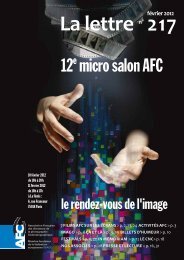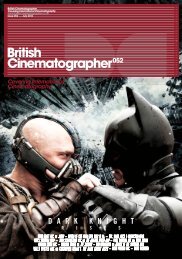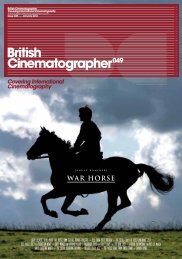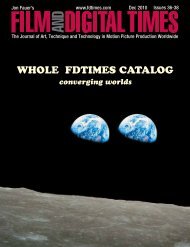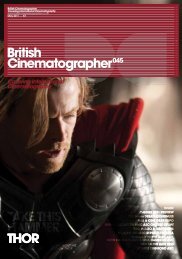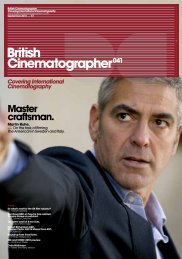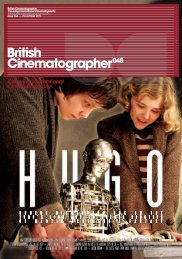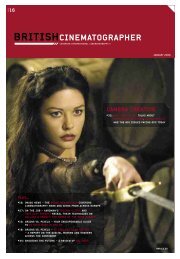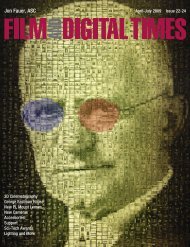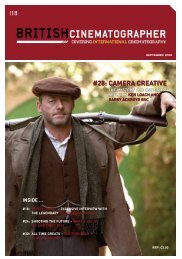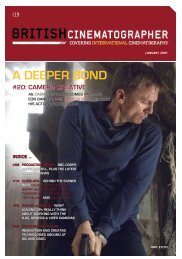British Cinematographer issue 51 - Imago
British Cinematographer issue 51 - Imago
British Cinematographer issue 51 - Imago
Create successful ePaper yourself
Turn your PDF publications into a flip-book with our unique Google optimized e-Paper software.
<strong>British</strong> <strong>Cinematographer</strong><br />
Covering International Cinematography<br />
www.britishcinematographer.co.uk<br />
Issue 0<strong>51</strong> ––– May 2012 32<br />
Camera Creative<br />
–––Bruno Delbonnel AFC ASC<br />
Dark Shadows<br />
Vampires... Delbonnel’s main<br />
concern during the shoot on Dark<br />
Shadows was how to shape the<br />
light on set using ambient lights<br />
and minimal direct beams.<br />
It was a Sunday afternoon, not so<br />
long ago, and Ron Prince caught up<br />
with Bruno Delbonnel AFC ASC over<br />
Skype, to discover more about his<br />
cinematography work on Tim Burton’s<br />
‘gonzo’ fantasy Dark Shadows. At the<br />
time, Delbonnel was in New York, and<br />
had just completed a fortnight of<br />
nights on Inside Llewyn Davis, the next<br />
feature from Joel and Ethan Coen.<br />
33<br />
Dark Shadows, a Zanuck Company/Warner Bros.<br />
production, is based on the gothic soap opera of the<br />
same name, transmitted on the ABC television network<br />
between 1966 and 1971. The original TV series is regarded<br />
as a camp classic, distinguished by melodramatic<br />
performances, atmospheric interiors, memorable<br />
storylines, dramatic plot twists, an adventurous musical<br />
score, and an epic cosmos of characters and heroic<br />
adventures. It became hugely popular when 200-year<br />
old vampire, Barnabas Collins, appeared a year into its<br />
run. Dark Shadows also featured werewolves, zombies,<br />
man-made monsters, witches, warlocks time travel and a<br />
parallel universe.<br />
Tim Burton’s new $100m film is based on a screenplay<br />
by Seth Grahame-Smith, and stars Johnny Depp as<br />
Barnabas Collins, with Michelle Pfeiffer as his reclusive,<br />
matriarchal cousin Elizabeth Collins Stoddard, and Eva<br />
Green as Angelique Bouchard, a vengeful witch who<br />
plots a vendetta against Barnabas and his family.<br />
The responsibility of bringing the story to life on the<br />
big screen, and delivering a fresh but distinctive look<br />
that typifies each movie on the Burton canon, fell to<br />
Delbonnel, whose big screen credits include Jean-Pierre<br />
Jeunet’s Amelie (2001) and A Very Long Engagement<br />
(2004), plus Across The Universe (2007), Harry Potter And<br />
The Half-Blood Prince (2009) and Faust (2011). Amongst<br />
his many gongs, Delbonnel has been Oscar nominated<br />
three times – for Amelie, A Very Long Engagement<br />
and Harry Potter – with notable wins including the ASC<br />
Award for outstanding achievement for A Very Long<br />
Engagement, and the Silver Frog at Camerimage<br />
for Across The Universe. Dark Shadows is his first<br />
collaboration with Burton.<br />
How did you get involved with the production of<br />
Dark Shadows?<br />
It’s great story. I was in Uruguay shooting a commercial<br />
and had two calls within the space of a couple of<br />
hours. One was from Richard Zanuck, offering me Dark<br />
Shadows, the other from Roman Polanski, who asked if<br />
I available to replace Pawel Edelman on Carnage, as<br />
Pawel had to attend to some urgent family matters. Two<br />
very interesting directors, and two completely different<br />
sorts of movies, both on the same day. It was quite<br />
a shock. It quickly transpired that Pawel was able to<br />
continue on Carnage, and so I went for Dark Shadows. I<br />
had met Tim only once before, at the world premiere of<br />
Harry Potter And The Half-Blood Prince in London. He told<br />
me then that he really liked what I’d done, and I assume<br />
that was the reason for the call.<br />
What appealed to you about Dark Shadows?<br />
The chance to work with Tim Burton. Who could possibly<br />
turn down the chance to work on one of his movies<br />
– he’s a genius. I had never heard of Dark Shadows<br />
before, although I learned it was a famous gothic soap<br />
opera, broadcast on weekdays in the US, and they<br />
made over 1,200 episodes. But it never made its way<br />
across the ocean to Europe. Johnny Depp and Tim<br />
Burton were kids when it was on TV, and they’d run home<br />
from school to watch the show. I believe Johnny wanted<br />
to be Barnabas Collins.<br />
<strong>British</strong> <strong>Cinematographer</strong><br />
Covering International Cinematography<br />
www.britishcinematographer.co.uk<br />
Issue 0<strong>51</strong> ––– May 2012<br />
What research did you do, and which creative<br />
references did you look at?<br />
I tried to watch some original episodes of Dark Shadows,<br />
but it did my head in. Whilst I got a sense of the engaging,<br />
creepy mood Tim wanted, they were shot in B&W, and<br />
are not interesting at all visually-speaking, especially in<br />
terms of the lighting. So I decided not to proceed any<br />
further. I read the script and found the same kind of<br />
poetry that are in all of Tim Burton’s movies. They are all<br />
character-driven too. When I started thinking about it,<br />
especially horror aspect, I watched Alfred Hitchcock’s<br />
Vertigo (1958, DP Robert Burks) again. Kim Novak is like<br />
a ghost character in that film. I thought it would be<br />
interesting to get this kind of Hollywood feeling, overlit<br />
faces, on top of a kind of strange B-movie strange color<br />
palette, and go towards the old Technicolor 2-strip look,<br />
which gave balanced, muted colours on flesh tones, but<br />
very strong reds. I looked too at movies from the early<br />
1970s, by cinematographers like Vilmos Zsigmond, to see<br />
how they created flares and the look that some of the<br />
crappy lenses produced back then. I also had an eye<br />
on the self-portraits of Francis Bacon, the distorted faces<br />
against flat orange, black and red backgrounds. Even<br />
though the sets on Dark Shadows were far from being flat,<br />
it was a starting point to show to Tim.<br />
What was Tim Burton’s reaction when you first discussed<br />
the look of Dark Shadows?<br />
He kind of liked it, but he has his own world of imagination.<br />
He’s not very specific, it’s more about a creating a mood,<br />
and he wanted creepiness from the first frame to the very<br />
last frame – a crisp, colourful but twisted look, to make<br />
the audience feel unsure and unsafe about the place,<br />
somewhere “in-between”, but totally artificial. We didn’t<br />
refer to any of his other films, they are done and in the<br />
past. This was something new and different, and that<br />
made it even more interesting for me.<br />
How much time did you have for prep/pre-production,<br />
and what were the working hours?<br />
The overall prep time was six months. I originally had<br />
two months of pre-production, but this turned into three<br />
months as Rick Heinrichs, the production designer,<br />
needed more time to deliver the production. So<br />
principal photography was pushed back. We started<br />
in May 2011 and wrapped on 4th October. The shoot,<br />
including second unit, was 18 weeks. We worked<br />
regular hours, five days a week. As 95% of the movie<br />
was shot on stages, I would go in most Saturdays to see<br />
how the sets we evolving.<br />
S h a d o w<br />
P l a y<br />
Tell us your reasoning behind your choice of equipment?<br />
During my first meeting with Tim we discussed film vs<br />
digital, and it took is about two minutes to choose<br />
film. We quickly arrived at shooting Super 1.85:1 too.<br />
After that, I was responsible for the entire selection of<br />
equipment. We used ARRI cameras, Cooke S4 lenses,<br />
Chapman dollies and a 50ft SuperTechnoCrane, all<br />
supplied via Panavision. I went with just one stock, Kodak<br />
Vision 3 5219 500ASA. It’s a fantastic grainless medium,<br />
with good latitude. I’m not sure why people choose<br />
different film stocks these days, as you can stop down<br />
enough in bright conditions or open up when it’s darker.<br />
Panalux supplied the lighting gear.<br />
Tell us about your crew?<br />
I love working with English crews, and my crew on Dark<br />
Shadows were fantastic. I never had a concern during<br />
the entire shoot. My gaffer was Chuck Finch, who I first<br />
worked with on Across The Universe in Liverpool, and<br />
then again with on Harry Potter. The key grip was Steve<br />
Ellingworth, who I also worked with on Potter. The camera<br />
operator, Des Wheelen, who has worked on several of<br />
Tim Burton’s movies, is the best I’ve ever worked with.<br />
Julian Bucknall, the 1st AC, and Steadicam/B-cam<br />
operator Peter Cavaciuti did a great job too.<br />
Tell us about you approach to the lighting?<br />
On most of the other films I’ve lit, I’ve been able to shape<br />
the light in any way I liked. But on Dark Shadows, my<br />
main concern throughout the production was that, as<br />
Barnabas Collins is a vampire, he cannot walk in direct<br />
sunlight. Tim didn’t want to set the movie entirely at<br />
night, and had sequences written into the script where<br />
Barnabas walks around the house during daylight hours,<br />
but through the shadows and shade of course. So I had<br />
to create fill and ambient lighting set-ups that would<br />
pick up details of the set, like the dark wooden paneling<br />
on the three massive interiors sets we had, but with very<br />
few direct beams. I knew I could push the stock, and<br />
that would also help get around the need to have a<br />
massive amount of lighting. It was pretty intense and<br />
quite complicated, as ambient lighting is kind of dull,<br />
and shaping the light to make the set look alive and not<br />
like a soap opera, can be a bit tricky. So I worked with all<br />
sorts of combinations soft, indirect and bounce lighting.<br />
We used Dinos and 20K fresnels, which we diffused a lot<br />
with large cloths, and lots of spacelights. We did have<br />
some fun with sharp 20K beams, which the actors could<br />
see and knew to walk around them.<br />
Was the camera generally on a dolly,<br />
handheld or on a Steadicam?<br />
We moved the camera either on the dolly or on the<br />
crane. We used crane for practicality, rather than for the<br />
movement. The main set in the hallway of the manor<br />
house was huge, and on travelling shots it just meant we<br />
could go faster.<br />
Did you shoot at practical locations, on sets, or both?<br />
The vast majority of the movie was shot on sets at<br />
Pinewood, where we built the interiors of the manor<br />
house. We also used the water tank at Pinewood for<br />
the harbour scene. It’s one of the biggest and most<br />
impressive sets I’ve ever seen, about 400 yards wide. We<br />
had fishing boats on the water and a couple of streets,<br />
complete with canneries, to look like Maine. I used a<br />
massive amount of lighting for those scenes – several<br />
Wendy lights, six soft boxes with 12 space lights in each,<br />
and eight cranes to suspend them all – and I’m sure<br />
they hate me because of the large electricity bill. For<br />
the exteriors of the manor house, Rick Heinrichs built the<br />
ground floor at Bourne Woods, near Farnham. We also<br />
used some of the nearby woods for the forest scenes –<br />
it’s the same place that John Mathieson shot on Robin<br />
Hood. We used Beckenham Place Park, in Kent, for a<br />
couple of scenes in a mental institution. The main forest<br />
scenes and the MacDonald construction site were shot<br />
in Crowthorne, Wokingham.<br />
What part does risk-taking play in your work, if any?<br />
Always. The risk is that I never try to do the same thing<br />
twice. Amelie, Potter, Faust, Dark Shadows, the new<br />
Coen Bothers’ film – they are all different from one<br />
another. I could rely on something, a technique, I know,<br />
but that’s not my way of thinking. How can I make the<br />
next movie different? That’s the risk!<br />
How did you work with Tim Burton on set?<br />
Generally, at the start of the day, Tim would talk to the<br />
actors on set about what he was expecting. Then we<br />
would clear the set completely, and Tim, myself and Des<br />
Wheelan would block the first three or four shots scene.<br />
We sort of storyboarded on the spot, on the day. Tim<br />
would then go back to his trailer and we’d call him when<br />
we were ready to go. During filming Tim would be either<br />
with me, or the actors. We would review takes on monitors<br />
in the video village, which in this case was a black tent,<br />
with just Tim, me and Katterli Frauenfelder the first AD.<br />
The final results look visually arresting, but there’s only so<br />
much you can achieve on set. How did you arrive at this<br />
distinctive look?<br />
I worked very closely with the DI Peter Doyle, the DI<br />
grader in pre-production, during production on the<br />
dailies. He’s a genius too, and my left arm. He graded<br />
Harry Potter And The Half-Blood Prince and Faust for<br />
me, and is also now grading the Coen’s Inside Llewyn<br />
Davis. We discussed references, talked a lot about<br />
the artistic aspects rather than the technical, and<br />
locked the look on Dark Shadows at an early stage.<br />
In pre-production on Dark Shadows, Peter created<br />
LUT software that could take what I had shot on set,<br />
and move the pictures a long way towards emulating<br />
the Technicolor 2-strip process. With this, it’s as though<br />
you are emphasising certain colours in a desaturated<br />
work. You get pure and strong red, green and blue<br />
colours, but everything else is muted and desturated,<br />
particularly the skin tones. For example, you see Eve<br />
Green (Angelique) in a shiny, shock-red dress, but her<br />
skin is very pale, and there’s still detail of things like the<br />
brown wooden panelling in the background.<br />
The overall look is attractive and fits the set and the<br />
story, I hope. I think the most interesting thing with Peter,<br />
is that we don’t do any windows anymore. We used the<br />
DI as we would use a lab process. We changed some<br />
of the curves of the neg, we changed some midtone<br />
colours without touching the others. But what you see<br />
on screen is the light I did on set. Typically, I would grade<br />
the HD dailies with Peter at Technicolor at Pinewood,<br />
between six and seven every morning, and then go<br />
to the set. Tim would then watch the dailies alone with<br />
Chris Lebenzon, the editor. He likes to keep the editing a<br />
very private process. After the shoot, Peter has worked<br />
closely with Tim on the grade, and I have held a number<br />
of remote, projected grading sessions with Peter – with<br />
me in New York, and him at Technicolor in Soho. Peter is<br />
coming to Technicolor New York, and we’ll complete the<br />
final grade for Tim.<br />
Were there any happy accidents, unexpected things<br />
that worked out well?<br />
Yes. There’s a scene early in the movie when Barnabas<br />
steps out of his coffin after 200 years, and walks through<br />
the forest at night to the manor house. Although I had<br />
Wendy lights, they didn’t really penetrate the foliage.<br />
When I checked my light meter it didn’t move, and<br />
thought “My God, I’m fucked!”. As we were shooting<br />
in June, I worked with the remains of the daylight, and<br />
crossed my fingers. But the results look beautiful. You<br />
can barely see anything, there are no highlights, just the<br />
shapes of the trees and the actor moving through the<br />
trees. It’s really spooky and eerie, and exactly the result I<br />
wanted. It was definitely a happy accident.



